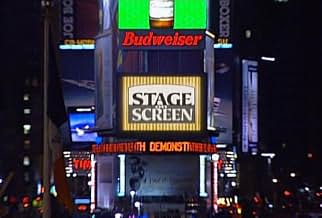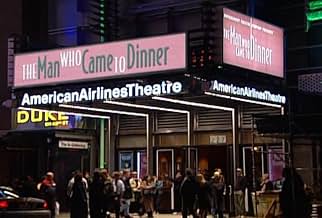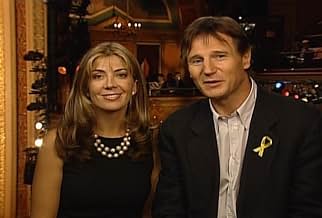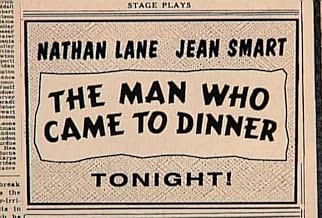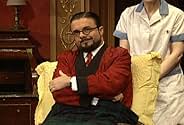Füge eine Handlung in deiner Sprache hinzuCantankerous theatre critic Sheridan Whiteside falls on an icy sidewalk, breaks his hip, and is temporarily stranded at the Ohio home of Richard Stanley and his family. While he's there, Whi... Alles lesenCantankerous theatre critic Sheridan Whiteside falls on an icy sidewalk, breaks his hip, and is temporarily stranded at the Ohio home of Richard Stanley and his family. While he's there, Whiteside turns life upside-down for everyone.Cantankerous theatre critic Sheridan Whiteside falls on an icy sidewalk, breaks his hip, and is temporarily stranded at the Ohio home of Richard Stanley and his family. While he's there, Whiteside turns life upside-down for everyone.
- Regie
- Drehbuch
- Hauptbesetzung
Harriet Sansom Harris
- Maggie Cutler
- (as Harriet Harris)
Jeff Hayenga
- John
- (as Jeffrey Hayenga)
Empfohlene Bewertungen
If you're in a mood to laugh yourself silly, this is the play for you. Nathan Lane is at his scenery-chewing best as Sheridan Whiteside (modeled on Alexander Woolcott), a critic, commentator, and friend of the great and near-great who is forced to spend several weeks in the home of a Middle America family for whom "Goodbye Mister Chips" is as high on the cultural scale as they go. Lewis Stadlen is equally hilarious as the manic, irrepressible Banjo (a takeoff of one of the Marx Brothers, but I'm not sure which). Jean Smart is wonderful as the haughty and man-eating Lorraine Sheldon, and Harriet Harris is superb as Maggie Cutler, Whiteside's devoted secretary and Lorraine's nemesis.
To get all the references, you'll need a copy of Who Was Who in Theater, Film, and Opera, but I'm glad they didn't try to update them. It just wouldn't have worked.
Finally, kudos to Ryan Shively (as Sandy, union organizer and June's fiancee)! A talented actor and an all-around great guy (okay, he's my roommate, so I'm a little biased)!
To get all the references, you'll need a copy of Who Was Who in Theater, Film, and Opera, but I'm glad they didn't try to update them. It just wouldn't have worked.
Finally, kudos to Ryan Shively (as Sandy, union organizer and June's fiancee)! A talented actor and an all-around great guy (okay, he's my roommate, so I'm a little biased)!
The 1942 film THE MAN WHO CAME TO DINNER was possibly the best comedy film that Bette Davis ever appeared in, but while she got starring position in the film's credits, the real star (who went to town as a result) was the great Monty Woolley, recreating his magnificent acid tongued curmudgeon Sheridan Whiteside. It was one of the rare occasions when a stage performance of importance was saved on film.
Fifty eight years later (forgetting one disastrous television version with Orson Welles as Whiteside in 1972) PBS showed this production of the stage revival of the play with Nathan Lane in the Whiteside role. Lane played the role perfectly, basing it (physically) closer to the original figure Whiteside is based on - writer, critic, actor, radio personality, and Algonquin Round Table Wit Alexander Woolcott. His facial appearance included wearing the round eye frame glasses that Woolcott wore all the time. Lane did not have the crusty, elderly asperity of the great Woolley, but he did have a malevolent elfin charm reminiscent of Woolcott (a man who was all too easy to dislike - Woolcott was also the model for Waldo Lydecker in LAURA, which just goes to show his popularity).
One of the problems with comedy (or drama generally speaking) is the fact that the works can be dated in their references. When, in one of his plays, Shakespeare refers to "the Great Sophy" it is to some long ago forgotten English traveler and diplomat named Shirley who went to Persia. Most of us see the foot note of this 16th Century reference and try to concentrate on the rest of the play that still is strong and relevant to us. But with THE MAN WHO CAME TO DINNER the great problem is the barrage of trivia that comes out of the play. Woolcott's two Algonquin friends (Kaufman and Moss Hart) added small bits of biography to his stage version, which everyone who knew Woolcott would recognize. The theater critic knew everyone of importance in the theater. So he has a scene with a clone of Noel Coward named Beverley Carlton (to add to perfecting the imitation of Coward, Kaufman and Hart asked Cole Porter, a close friend of Monty Woolley, to write a song for "Carlton" to sing to Whiteside, that was in Coward's distinct delicate style). The close friend of Whiteside who shows up as a comic "deus ex ma china" in the play is "Banjo." This was based on Woolcott's close Algonquin friend Harpo Marx.
But most of the references are quite arcane. Who is Elizabeth Sedley? Well, it is a reference to a celebrated murder case defendant, whose career would have intrigued Woolcott, the great amateur criminologist. What are the references to Beebe and Byrd? This version got around the problems using mock 1930s newspaper headlines chronicling William Beebe the oceanographer and Admiral Richard Byrd, the Polar explorer. This sounds cumbersome, but it was far more effective and useful to the viewers than the idiocy of the 1972 Welles' version where the script was "up-dated" meaninglessly.
The program was an excellent version of the classic comedy, and well worth comparing with the Woolley film. I feel that it deserves a "10".
Fifty eight years later (forgetting one disastrous television version with Orson Welles as Whiteside in 1972) PBS showed this production of the stage revival of the play with Nathan Lane in the Whiteside role. Lane played the role perfectly, basing it (physically) closer to the original figure Whiteside is based on - writer, critic, actor, radio personality, and Algonquin Round Table Wit Alexander Woolcott. His facial appearance included wearing the round eye frame glasses that Woolcott wore all the time. Lane did not have the crusty, elderly asperity of the great Woolley, but he did have a malevolent elfin charm reminiscent of Woolcott (a man who was all too easy to dislike - Woolcott was also the model for Waldo Lydecker in LAURA, which just goes to show his popularity).
One of the problems with comedy (or drama generally speaking) is the fact that the works can be dated in their references. When, in one of his plays, Shakespeare refers to "the Great Sophy" it is to some long ago forgotten English traveler and diplomat named Shirley who went to Persia. Most of us see the foot note of this 16th Century reference and try to concentrate on the rest of the play that still is strong and relevant to us. But with THE MAN WHO CAME TO DINNER the great problem is the barrage of trivia that comes out of the play. Woolcott's two Algonquin friends (Kaufman and Moss Hart) added small bits of biography to his stage version, which everyone who knew Woolcott would recognize. The theater critic knew everyone of importance in the theater. So he has a scene with a clone of Noel Coward named Beverley Carlton (to add to perfecting the imitation of Coward, Kaufman and Hart asked Cole Porter, a close friend of Monty Woolley, to write a song for "Carlton" to sing to Whiteside, that was in Coward's distinct delicate style). The close friend of Whiteside who shows up as a comic "deus ex ma china" in the play is "Banjo." This was based on Woolcott's close Algonquin friend Harpo Marx.
But most of the references are quite arcane. Who is Elizabeth Sedley? Well, it is a reference to a celebrated murder case defendant, whose career would have intrigued Woolcott, the great amateur criminologist. What are the references to Beebe and Byrd? This version got around the problems using mock 1930s newspaper headlines chronicling William Beebe the oceanographer and Admiral Richard Byrd, the Polar explorer. This sounds cumbersome, but it was far more effective and useful to the viewers than the idiocy of the 1972 Welles' version where the script was "up-dated" meaninglessly.
The program was an excellent version of the classic comedy, and well worth comparing with the Woolley film. I feel that it deserves a "10".
What a treat to watch. Having recently portrayed the role of Mr. Whiteside in a local civic theatre production, I was reluctant to view the movie beforehand, so that I might give the pompous "Babys Breath" my own take. I am proud to report that as much as a a non professional can, I approached the character much like Mr. Lane did.(Only with a bit more heavy handed shouting)Jean Smart is always a treat to watch in anything she does, and I agree, that the role of Banjo was handled with the appropriate lunacy. Also excellent was Harriet Harris. She was able to convey the intimacy that comes from years of being someones right hand, and then to lose that when you have been sidelined by that very same person. It is a wonderful movie to watch. And one of my most favorite roles on stage.
As someone who goes out of his way to see performances of "The Man Who Came to Dinner"--one of the greatest comic concoctions of the 20th century--I thought this was the best media presentation of the play to date, much better than the 1940 film version. My only quibble concerns the decision to pattern Lewis Stadlen's Banjo after Jimmy Durante's version in the film, rather than Harpo Marx (upon whom the character was originally modelled), but that's a matter of personal taste. (And to be fair, Stadlen does just fine, perhaps even out-Duranting Durante.) Conversely, I can't imagine anyone better in the title role than Nathan Lane, and he lives up to my hopes splendidly. (I hope PBS broadcasts him in "The Producers" one of these days!)
What a wonderful, witty comedy this is. I was so glad PBS broadcasted this terrific stage production. Beautifully directed by Jerry Zaks. I loved all the performances, but Jean Smart was especially fabulous as the ridiculous Lorraine Sheldon. The dialogue in this play is so good that even if you don't get an opportunity to see it, you'll get a good chuckle out of reading the script.
Wusstest du schon
- WissenswertesThe part of Banjo was originally based on Alexander Woollcott's good friend, Harpo Marx. However, in this production, the character is blatantly patterned after Jimmy Durante, who played the role in the 1942 film adaptation.
- Zitate
Sheridan Whiteside: I may vomit.
- VerbindungenReferenced in My Boys: Free Agent (2006)
Top-Auswahl
Melde dich zum Bewerten an und greife auf die Watchlist für personalisierte Empfehlungen zu.
Details
- Erscheinungsdatum
- Herkunftsland
- Sprache
- Drehorte
- New York City, New York, USA(American Airlines Theater)
- Produktionsfirmen
- Weitere beteiligte Unternehmen bei IMDbPro anzeigen
Zu dieser Seite beitragen
Bearbeitung vorschlagen oder fehlenden Inhalt hinzufügen


